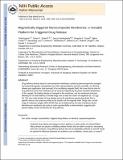| dc.contributor.author | Hoare, Todd | |
| dc.contributor.author | Timko, Brian P. | |
| dc.contributor.author | Santamaria, Jesus | |
| dc.contributor.author | Goya, Gerardo F. | |
| dc.contributor.author | Irusta, Silvia | |
| dc.contributor.author | Lau, Samantha | |
| dc.contributor.author | Stefanescu, Cristina F. | |
| dc.contributor.author | Lin, Debora | |
| dc.contributor.author | Kohane, Daniel S. | |
| dc.contributor.author | Langer, Robert S | |
| dc.date.accessioned | 2013-09-16T20:05:06Z | |
| dc.date.available | 2013-09-16T20:05:06Z | |
| dc.date.issued | 2011-02 | |
| dc.identifier.issn | 1530-6984 | |
| dc.identifier.issn | 1530-6992 | |
| dc.identifier.uri | http://hdl.handle.net/1721.1/80763 | |
| dc.description | Author Manuscript 2012 March 9. | en_US |
| dc.description.abstract | Drug delivery devices based on nanocomposite membranes containing thermoresponsive nanogels and superparamagnetic nanoparticles have been demonstrated to provide reversible, on−off drug release upon application (and removal) of an oscillating magnetic field. We show that the dose of drug delivered across the membrane can be tuned by engineering the phase transition temperature of the nanogel, the loading density of nanogels in the membrane, and the membrane thickness, allowing for on-state delivery of model drugs over at least 2 orders of magnitude (0.1−10 μg/h). The zero-order kinetics of drug release across the membranes permit drug doses from a specific device to be tuned according to the duration of the magnetic field. Drugs over a broad range of molecular weights (500−40000 Da) can be delivered by the same membrane device. Membrane-to-membrane and cycle-to-cycle reproducibility is demonstrated, suggesting the general utility of these membranes for drug delivery. | en_US |
| dc.description.sponsorship | Ruth L. Kirschstein National Research Service Award | en_US |
| dc.description.sponsorship | National Institutes of Health (U.S.) (Award F32GM096546) | en_US |
| dc.language.iso | en_US | |
| dc.publisher | American Chemical Society (ACS) | en_US |
| dc.relation.isversionof | http://dx.doi.org/10.1021/nl200494t | en_US |
| dc.rights | Article is made available in accordance with the publisher's policy and may be subject to US copyright law. Please refer to the publisher's site for terms of use. | en_US |
| dc.source | PMC | en_US |
| dc.title | Magnetically Triggered Nanocomposite Membranes: A Versatile Platform for Triggered Drug Release | en_US |
| dc.type | Article | en_US |
| dc.identifier.citation | Hoare, Todd, Brian P. Timko, Jesus Santamaria, Gerardo F. Goya, Silvia Irusta, Samantha Lau, Cristina F. Stefanescu, Debora Lin, Robert Langer, and Daniel S. Kohane. Magnetically Triggered Nanocomposite Membranes: A Versatile Platform for Triggered Drug Release. Nano Letters 11, no. 3 (March 9, 2011): 1395-1400. | en_US |
| dc.contributor.department | Massachusetts Institute of Technology. Department of Chemical Engineering | en_US |
| dc.contributor.department | Koch Institute for Integrative Cancer Research at MIT | en_US |
| dc.contributor.mitauthor | Timko, Brian P. | en_US |
| dc.contributor.mitauthor | Lau, Samantha | en_US |
| dc.contributor.mitauthor | Lin, Debora | en_US |
| dc.contributor.mitauthor | Langer, Robert | en_US |
| dc.relation.journal | Nano Letters | en_US |
| dc.eprint.version | Author's final manuscript | en_US |
| dc.type.uri | http://purl.org/eprint/type/JournalArticle | en_US |
| eprint.status | http://purl.org/eprint/status/PeerReviewed | en_US |
| dspace.orderedauthors | Hoare, Todd; Timko, Brian P.; Santamaria, Jesus; Goya, Gerardo F.; Irusta, Silvia; Lau, Samantha; Stefanescu, Cristina F.; Lin, Debora; Langer, Robert; Kohane, Daniel S. | en_US |
| dc.identifier.orcid | https://orcid.org/0000-0002-7958-8980 | |
| dc.identifier.orcid | https://orcid.org/0000-0003-4255-0492 | |
| mit.license | PUBLISHER_POLICY | en_US |
| mit.metadata.status | Complete | |
